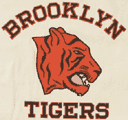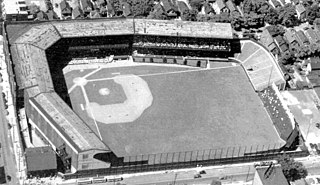
The Providence Steam Rollers were a professional American football team based in Providence, Rhode Island in the National Football League (NFL) from 1925 to 1931. Providence was the first New England team to win an NFL championship. The Steam Roller won the league's championship in 1928, which is the latest NFL championship win by a defunct team to date. Most of their home games were played at the Cycledrome, a 10,000-seat stadium that was built as a velodrome for bicycle races.

The Orange Tornadoes and Newark Tornadoes were two manifestations of a long-lived professional American football franchise that existed in some form from 1887 to 1941 and from 1958 to 1970, having played in the American Amateur Football Union from 1888 to 1895, the National Football League from 1929 to 1930, the American Association from 1936 to 1941, the Atlantic Coast Football League from 1963 to 1964 and 1970, and the Continental Football League from 1965 to 1969. The team was based for most of its history in Orange, New Jersey, with many of its later years in Newark. Its last five seasons of existence were as the Orlando Panthers, when the team was based in Orlando, Florida. The NFL franchise was sold back to the league in October 1930. The team had four head coaches in its two years in the NFL – Jack Depler in Orange, and Jack Fish, Al McGall and Andy Salata in Newark.

The Rock Island Independents were a professional American football team, based in Rock Island, Illinois, from 1907 to 1926. The Independents were a founding National Football League franchise. They hosted what has been retrospectively designated the first National Football League game on September 26, 1920 at Douglas Park. The Independents were founded in 1907 by Demetrius Clements as an independent football club. Hence, the team was named the "Independents."
The Staten Island Stapletons also known as the Staten Island Stapes were a professional American football team founded in 1915 that played in the National Football League from 1929 to 1932. The team was based in the Stapleton section of Staten Island. They played under the shortened nickname the "Stapes" the final two seasons. Jack Shapiro, who was a blocking back for the Stapletons, was the shortest player in NFL history.

The Brooklyn Dodgers were an American football team that played in the National Football League from 1930 to 1943, and in 1944 as the Brooklyn Tigers. The team played its home games at Ebbets Field of the baseball National League's team, the Brooklyn Dodgers. In 1945, because of financial difficulties and the increasing scarcity of major league-level players because of the war-time defense requirements at the height of World War II, the team was merged with the Boston Yanks and were known as the Yanks for that season.

The Polo Grounds was the name of three stadiums in Upper Manhattan, New York City, used mainly for professional baseball and American football from 1880 through 1963. The original Polo Grounds, opened in 1876 and demolished in 1889, was built for the sport of polo. Bound on the south and north by 110th and 112th streets and on the east and west by Fifth and Sixth (Lenox) avenues, just north of Central Park, it was converted to a baseball stadium when leased by the New York Metropolitans in 1880.

League Park was a baseball park located in Cleveland, Ohio, United States. It was situated at the northeast corner of Dunham Street and Lexington Avenue in the Hough neighborhood. It was built in 1891 as a wood structure and rebuilt using concrete and steel in 1910. The park was home to a number of professional sports teams, most notably the Cleveland Indians of Major League Baseball. League Park was first home to the Cleveland Spiders of the National League from 1891 to 1899 and of the Cleveland Lake Shores of the Western League, the minor league predecessor to the Indians, in 1900. From 1914 to 1915, League Park also hosted the Cleveland Spiders of the minor league American Association. In the late 1940s, the park was also the home field of the Cleveland Buckeyes of the Negro American League.

Griffith Stadium stood in Washington, D.C., from 1911 to 1965, between Georgia Avenue and 5th Street, and between W Street and Florida Avenue NW.

Crosley Field was a Major League Baseball park in Cincinnati, Ohio. It was the home field of the National League's Cincinnati Reds from 1912 through June 24, 1970, and the original Cincinnati Bengals football team, members of the second (1937) and third American Football League (1940–41). It was not the original home of the current NFL franchise of the same name: the home of those Bengals in 1968 and 1969 was nearby Nippert Stadium, located on the campus of the University of Cincinnati. Crosley Field was on an asymmetrical block bounded by Findlay Street (south), Western Avenue, Dalton Avenue (east), York Street (north) and McLean Avenue (west) in the Queensgate section of the city. Crosley has the distinction of being the first major-league park with lights for playing night games.

Exposition Park was the name given to three historic stadiums, located in what is today Pittsburgh, Pennsylvania. The fields were used mainly for professional baseball and American football from c. 1879 to c. 1915. The ballparks were initially located on the north side of the Allegheny River in Allegheny City, Pennsylvania. The city was annexed into Pittsburgh in 1907, which became the city's North Side, located across from Pittsburgh's downtown area. Due to flooding from the nearby river, the three stadiums' exact locations varied somewhat. The final version of the ballpark was between the eventual sites of Three Rivers Stadium and PNC Park.

St. George Cricket Grounds or St. George Grounds is a former baseball venue located on Staten Island, New York. St. George was the home park for the New York Metropolitans of the American Association for the 1886 and 1887 seasons. The grounds were also a part-time home to the New York Giants of the National League in 1889.

The Staten Island University Hospital Community Park is a baseball stadium located on the northeastern tip of Staten Island in New York City. The ballpark is the home of the Staten Island FerryHawks, a member of the Atlantic League of Professional Baseball, and is the largest stadium in the league by capacity, at 7,171. Since 2022, it has also been the home of the Wagner College Seahawks baseball team. In addition, local high schools have the chance to play at least one game a season at the park.

The 1920 season was the Decatur Staleys 2nd season of existence, the first professional season of the franchise that would go on to be known as the Chicago Bears and their first under head coach George Halas, competing in the newly formed American Professional Football Association.
The Newark Bears were a professional American football team that competed in the first American Football League in 1926 AFL season. Owned by the New Jersey Athletic Association, the Bears played their home games in Davids' Stadium. Coached by player-coach Hal Hansen, the majority of the team played their college football in Georgia and Florida.
The Allegheny Athletic Association was an athletic club that fielded the first ever professional American football player and later the first fully professional football team. The organization was founded in 1890 as a regional athletic club in Allegheny, Pennsylvania, which is today the North Side of Pittsburgh.
The first National Football League (NFL) was the first attempt at forming a national professional American football league in 1902. This league has no ties with the modern National Football League. In fact the league was only composed of teams from Pennsylvania, which meant it was actually regional, despite having locations in the two largest cities in Pennsylvania. Two of the teams were based in Philadelphia, while the third was based in Pittsburgh. This NFL was a curious mixture of football players and baseball players who adapted to playing football. Future Baseball Hall of Famer Rube Waddell was with the Philadelphia Athletics, and pitcher Christy Mathewson a fullback for Pittsburgh. Two of the three teams were owned by the Philadelphia Phillies and Philadelphia Athletics, with the third team suspected of being owned by the Pittsburgh Pirates. The league folded after the 1902 season.
The 1925 Chicago Cardinals–Milwaukee Badgers scandal was a scandal centered on a 1925 game between the Chicago Cardinals and the Milwaukee Badgers of the National Football League. The scandal involved a Chicago player, Art Folz, hiring a group of high school football players to play for the Milwaukee Badgers against the Cardinals. This would ensure an inferior opponent for Chicago. The game was used to help prop up their win–loss percentage and as a chance of wresting the 1925 Championship away from the first place Pottsville Maroons.
Daniel Blaine (1891–1958) was a professional football player for the Staten Island Stapletons from 1915 until 1924. In 1915 he, along with three other players, formed the team to play other semi-pro teams from New York and New Jersey. He suspended his football career in 1918 to serve in the United States military during World War I. Once the war ended, Blaine took over sole ownership of the Stapletons. He stayed in the Stapleton lineup at halfback until ending his playing career in 1924 at age 33. After his retirement from football, Blaine focused solely on owning and managing the team.
Jack Emanuel "Soupy" Shapiro was an American gridiron football player who played in one game with the Staten Island Stapletons of the National Football League (NFL) in 1929. Shapiro is most famous for being the shortest player in NFL history at about 5 ft 1 in (1.55 m).
Kinsley Park was an athletic field, used for professional football, minor league baseball and pro soccer, located in Providence, Rhode Island at the corner of Kinsley Avenue and Acorn Street, across Acorn from the Nicholson File Company Mill Complex. The field was used primarily by Providence Steam Roller, Providence Grays and the Providence Gold Bugs. The park was built primarily by Peter Laudati, a prominent Providence real estate developer and a part-owner of the Providence Steam Roller. He also built the Steam Roller's second stadium, the Cycledrome. During the 1930s the New York Yankees, featuring Babe Ruth and Lou Gehrig played an exhibition game at that park.
















